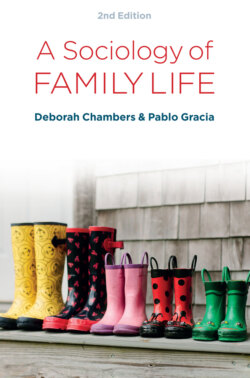Читать книгу A Sociology of Family Life - Deborah Chambers - Страница 15
Community and kinship studies
ОглавлениеIdeas about the decline of communal relations, the privatization of social life and a disintegration of family values continued to dominate academic and public debates of the 1950s and 1960s. Since industrialization, traditional commitments were being replaced by new kinds of loyalties and commonalities influenced by wider social and economic changes beyond the family, such as consumerism and geographical and social mobility. Changes in the structure of housing were also thought to be changing social ties. For example, after World War II, between the late 1940s and 1960s, the clearance of slum areas in Britain and other parts of war-torn Europe coincided with the building of new housing estates on the edge of urban areas, which weakened traditional working-class communities (Crow and Allan 1994). Governments and academics feared that higher standards of new housing stock were accompanied by lower levels of social participation and less informal support, so that families often felt isolated (Crow and Allan 1994; Mogey 1956; Willmott 1963; Willmott and Young 1960).
During the mid twentieth century, sociologists expressed concern about the decline of civic participation and the sense of atomization associated with isolated nuclear families that had become more inwardly focused on domestic matters, as well as the ‘problem’ of marriage breakdown and divorce. However, a series of classic kinship studies conducted in Britain during that period indicated that the notion of a ‘decline’ or ‘death’ of kinship had been overstated. Studies documented changes in the context of modernity and uncovered the richness of family life, highlighting the strength of generational ties. For example, Young and Willmott’s classic study of Family and Kinship in East London (1957, 1987) underlined the importance and positive value of extended family bonds despite widespread social change, as did Townsend’s The Family Life of Old People (1957). Kinship support was accepted as a normal aspect of everyday life, particularly among working-class communities, and there was little evidence of segregated nuclear family units.
Communities of the 1950s were proven to have close-knit and supportive networks. For example, in his study of a group of residents from a block of flats in a working-class area of South London, Raymond Firth (1956) found that individuals had more extensive knowledge of their kin than first thought. Although people knew little about distant ancestors and could only trace their lineage back to grandparents, they had a remarkably broad knowledge of living relatives. Many of these kin were important to their lives because they were the people they could call on for help in times of crisis. Several of these classic studies demonstrated that membership of extended families was more complex than initially thought. Rather than being static, these kin relationships were adaptable and permeable. In this respect, public anxieties about the decline of kinship cohesion were found to be misleading.
Nevertheless, the degree of social participation in the past can be overstated because social divisions between people are often overlooked (Devine 1992). Research from the 1950s indicates important gender differences, with women’s lives often more home-centred, and men’s leisure activities typically more communal and located in public areas such as pubs and clubs. This is shown by classic research such as a study of a Yorkshire mining community, Coal is Our Life, by Dennis and colleagues (1956). For women, the sense of social isolation was often apparent, given that organized female sociability in public settings was traditionally regulated and restricted. During this period, gender was a major factor affecting individuals’ opportunities for sociable interaction, as well as social class. In terms of class, many forms of working-class employment continue to restrict the time and economic resources needed to engage in various kinds of leisure. However, from the mid twentieth century, the home had become a progressively more socialized space among both working-class and middle-class families (Franklin 1989), especially given the rise in the so-called ‘network society’ triggered by information technology (Chambers 2006; Wellman 1979).
